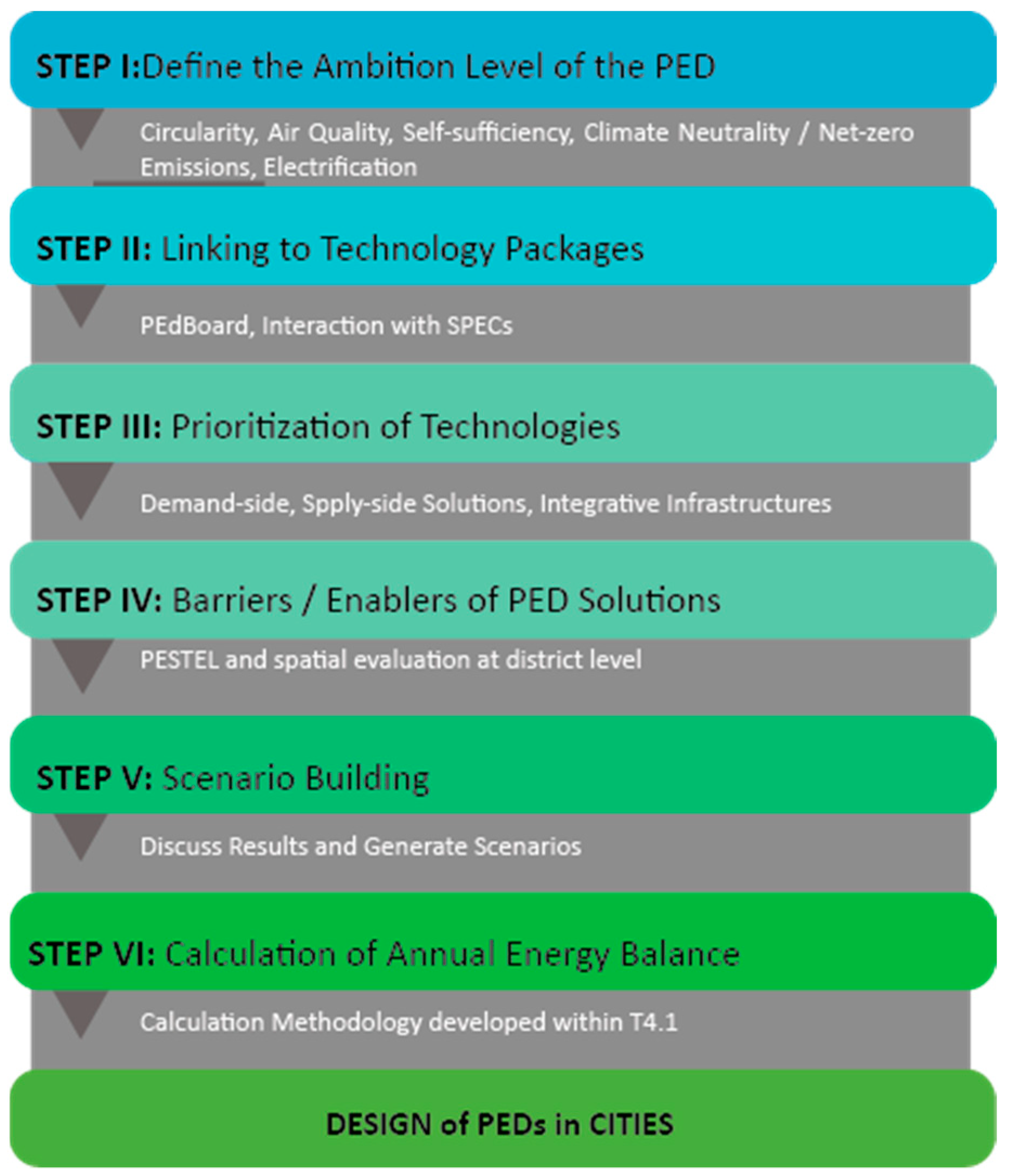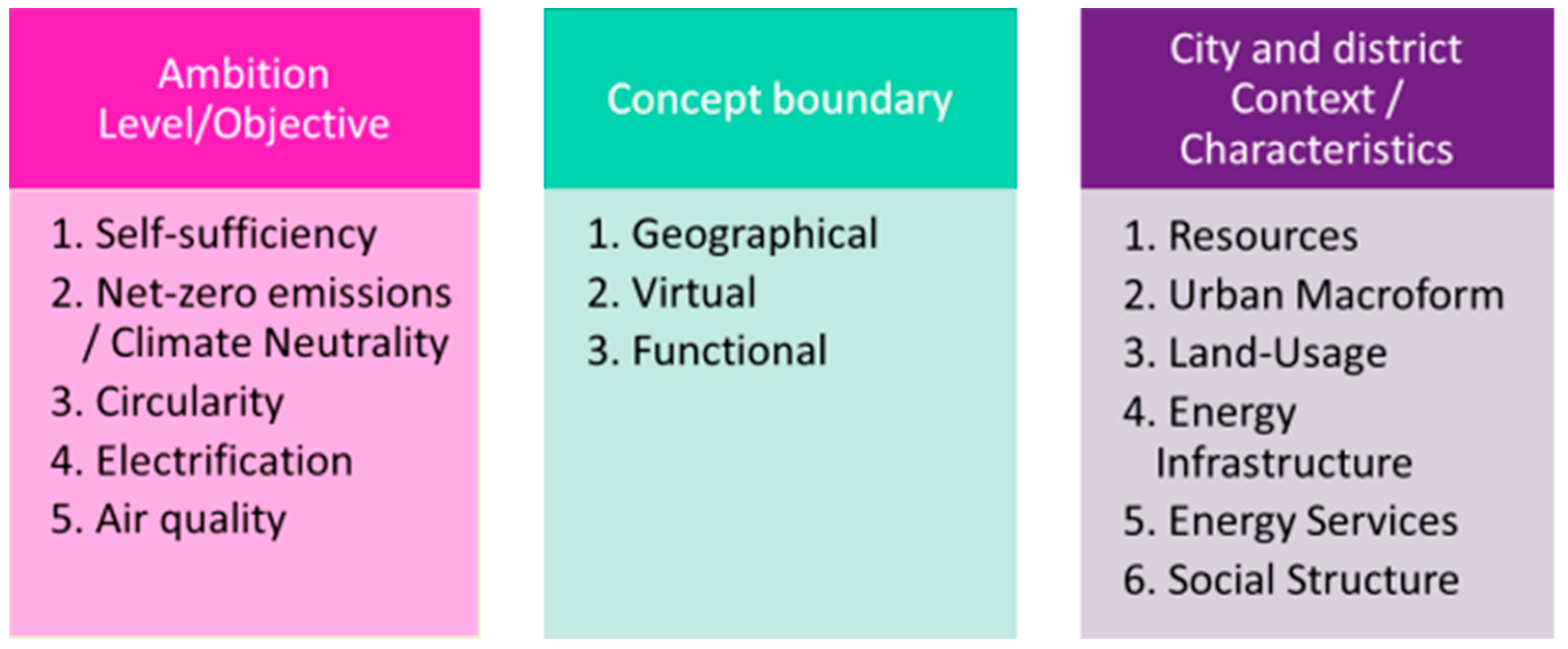1. Introduction
While only 2% of the Earth’s surface is covered by cities, they contribute to more than 60 per cent of greenhouse gas emissions [
1,
2]. Currently, over 68% of Europeans live in cities, and this number will rise. In 2050, it is expected that 70% of the world population will live in cities. That is why cities are committing to strong objectives, otherwise the world will be heading for a temperature rise beyond the Paris Agreement goals [
3]. In Europe, various concepts have emerged, such as nearly zero energy buildings (NZEB), installation of renewable energy sources (RES) [
4], waste recovery technologies [
5], innovative storage solutions [
6] and local energy communities [
7] (which in principle leads to a high involvement of citizens). Literally, positive energy districts (PED) are just a combination of the above-mentioned solutions applied in a specific area.
Multiple definitions of PEDs are currently being used [
8,
9,
10]. For MAKING-CITY project, PED is “an urban area with clear boundaries, consisting on buildings of different typologies that actively manage the energy flow between them and the larger energy system to reach an annual positive non-renewable primary energy balance” [
11]. To implement the PED concept, RES, information and communications technology solutions, interaction with external grids and outside boundaries and, reduction of the energy demand are needed [
8,
9,
10]. MAKING-CITY developed a methodology for designing PEDs in cities [
11,
12,
13], and one of the phases refers to the identification and selection of the PED technologies that cities will test inside their PED boundaries. In this decision making-process, most cities struggle due to the lack of information of innovative technologies and especially on how to achieve a positive energy balance at district level, integrating different energy carriers and technologies. Thus, a tool has been developed within MAKING-CITY [
14], with the collaboration of ATELIER project [
15], to assist PED technology selection processes, empowering cities with information and recommendations in line with their district context, city’s needs, and objectives.
The first step of the tool is to decide the objective of the city by implementing a PED and the district boundaries considered for it (geographical, virtual or functional). Then, district context questions on resource availability, urban macroform, land use context, energy infrastructure and services (intended to be supplied by the PED to the wider grids to the district heating, power and gas networks) and social structure, are directed. In each step, different hints are given as an attempt to assist cities for understanding the questions properly. Finally, a diagram of the PED is presented, displaying the interconnections between technologies, grids and buildings, and providing recommendations to be considered by links to a technology solution catalogue of the individual solutions.
2. Methodology for PED Technologies Selection
The overall methodology for PED design of MAKING-CITY is a procedure composed of five phases encompassing a decision-making route that underlines citizen engagement throughout this process. It considers the priorities and needs of the cities, followed by the identification process of the PED concept boundary and selection of proper PED solutions peculiar to the cities. One of the phases of the methodology for PED design under MAKING-CITY underlines the need for selecting which kind of actions, elements and technologies that the cities would like to install in the identified PED area. This phase has been divided into six steps to guide cities in the decision-making route for selecting different technical and non-technical solutions that could lead to achieve a positive energy balance and at the same time, fulfill their city objectives. At step I, the level of ambition of the PED is decided. At step II, the PED technology tool is used, to direct the city in order to link to technology packages. At step III, the city prioritizes some technologies from the recommended technologies of the tool. At step IV, barriers or enablers of those technologies could be analyzed (if needed, the city can go back to step II). At step V, different scenarios combining the selected technologies can be analyzed, and as a result of all these efforts, annual energy balance can be calculated (Step VI) to evaluate if the annual positive energy balance has been achieved. The steps are illustrated in
Figure 1.
The algorithm of the decision-making route, has a decision tree behind, where each question adds/removes some technical and non-technical solution to/from the list, and at the end the technologies are connected to each other (by developing parties) forming a technology package. The decision tree will be programmed in a web-based tool accessible to all cities, where different questions are directed and as a result, a technology package is recommended. The questions are divided in three blocks, as shown in
Figure 2.
The answers to each question will add/discard some technologies. For example, if your ambition level is to achieve self-sufficiency, technologies such as thermal and electric storage are recommended. When geographical limits are chosen, big power plants such as wind turbines or hydropower are not recommended, as they are usually located outside the district limits. If there is space available in any roof, solar photovoltaics and solar thermal technologies on roofs are recommended.
3. Technology Selection Assistance Tool Format
The combination of the technologies will result in a recommend technology package (see
Figure 3). In
Figure 3, the technology package shows that there is interaction with the wider infrastructures, such as the electricity grid, and the on-site technologies, such as photovoltaic panels can supply the demand of the buildings and the water–water heat pump, as well as e-cars’ demands. When the technology package is recommended, the user/city can access to more information individually per technology (through the SPEC cards [
11]). The results of the tool are organized as a technology package since PEDs cannot be identified by stand-alone technologies.
The recommendations will guide the city about the possibilities of technologies, connections between technologies, buildings, storage, and mobility solutions, and possibly about non-technical solutions, such as business models could be recommended. Each technology within the package is linked with the associated so-called “SPEC Card”, which are the detail cards within MAKING-CITY solution catalogue. General information on the technology, how it works, associated business model and stakeholders, expected impacts, replication potential, barriers/enablers for implementing the solution and its integration with other smart solutions are detailed in the associated card. All SPEC Cards may be reviewed under “PEDBoard”—the solution catalogue [
11].
4. Results: Testing the Tool within the Projects
MAKING-CITY is a large-scale H2020 Smart Cities and Communities demonstration project aiming at the development of new integrated strategies to address the urban energy system transformation towards low carbon cities, with the positive energy district (PED) approach as the core of the urban energy transition pathway. The insights of Groningen (Netherlands) and Oulu (Finland), as “lighthouse cities”, will be adopted by the six follower cities of Bassano del Grappa (Italy), Kadıköy (Turkey), León (Spain), Lublin (Poland), Trenčín (Slovakia) and Vidin (Bulgaria). The six follower cities will test the tool within the project to help their decision-making process of designing their PED implementations. A similar approach will be followed with the six follower cities of ATELIER project. The tool will guide cities in the decision-making route for selecting different technical and non-technical solutions that could help cities to achieve the PED concept.
For now, the tool was presented in a webinar and a MURAL workshop was conducted to get feedback. The gaps identified were: questions may be linked with the local innovation ecosystems; affordability and cost of the technologies must be addressed in order to identify the target of the district; questions regarding nature-based solutions, waste/materials/water reuse should be integrated; and the tool should support the pre-feasibility stage.
The tool goes beyond the state-of-the art technology catalogues with an integrated approach. The tool aims to empower municipalities, citizens or any developer by providing hints and recommendations for technologies integration, interaction with the wider grids and information on single technologies and, therefore, be a step closer in the energy transition towards the desired city. This publication will be followed by another one that will analyze the impact of the tool and the results within follower cities of MAKING-CITY and ATELIER projects.
Author Contributions
Introduction, C.S.M., B.A. and A.G.M.; methodology, B.A. and A.G.M.; software, A.G.M.; validation with cities, B.A. and A.G.M.; visualization, A.G.M.; writing—review and editing, C.S.M., B.A. and A.G.M.; project administration, C.S.M. All authors have read and agreed to the published version of the manuscript.
Funding
This research has received funding from the European Union’s Horizon 2020 research and innovation program under grant agreement No. 824418 (MAKING-CITY).
Acknowledgments
CARTIF is a Cervera’s Centre of Excellence, granted by the Ministry of Science and Innovation and the Centre for Technological and Industrial Development (CDTI) under the work record CER20191019. The authors are grateful of ATELIER’s project collaboration.
Conflicts of Interest
The authors declare no conflict of interest.
References
- Burgelman, S. Just 25 Mega-Cities Produce 52% of the World’s Urban Greenhouse Gas Emissions. 12 July 2021. Available online: https://blog.frontiersin.org/2021/07/12/just-25-mega-cities-produce-52-of-the-worlds-urban-greenhouse-gas-emissions/ (accessed on 13 September 2021).
- UNEP; UNEP DTU Partnership. Emissions Gap Report. 2020. Available online: https://www.unep.org/emissions-gap-report-2020 (accessed on 13 September 2021).
- United Nations. Cities and Pollution. 2021. Available online: https://www.un.org/en/climatechange/climate-solutions/cities-pollution#:~:text=According%20to%20UN%20Habitat%2C%20cities,cent%20of%20the%20Earth’s%20surface (accessed on 13 September 2021).
- Kalogirou, S.A. Building integration of solar renewable energy systems towards zero or nearly zero energy buildings. Int. J. Low-Carbon Technol. 2015, 10, 379–385. [Google Scholar] [CrossRef] [Green Version]
- Jouhara, H.; Khordehgah, N.; Almahmoud, S.; Delpech, B.; Chauhan, A.; Tassou, S.A. Waste heat recovery technologies and applications. Therm. Sci. Eng. Prog. 2018, 6, 268–289. [Google Scholar] [CrossRef]
- Kunkel, A.; Schwab, H.; Bruckner, T.; Kümmel, R. Combined Heat and Power Innovative Storage Concepts. In Brennstoff-Waerme-Kraft; Springer: Berlin/Heidelberg, Germany, 1996; pp. 54–60. [Google Scholar]
- Olivadese, R.; Alpagut, B.; Revilla, B.P.; Brouwer, J.; Georgiadou, V.; Woestenburg, A.; van Wees, M. Towards Energy Citizenship for a Just and Inclusive Transition: Lessons Learned on Collaborative Approach of PED from the EU Horizon 2020 Smart Cities and Communities Projects. Proceedings 2021, 65, 20. [Google Scholar] [CrossRef]
- JPI Urban Europe: White Paper on PED Reference Framework for PEDs and Neighbourhoods. 2020; pp. 1–22.
- Wyckmans, A.; Karatzoudi, K.; Brigg, D.; Ahlers, D. D9.5: Report on Attendance at Events Held by Other SCC-01 Co-Ordinators; +CityxChange Project Deliverable; 2019; Available online: https://cityxchange.eu/knowledge-base/report-on-attendance-at-events-held-by-other-scc-01-co-ordinators-2/ (accessed on 13 September 2021).
- Lindholm, O.; Reda, F. Positioning Positive Energy Districts in European Cities. Buildings 2021, 11, 19. [Google Scholar] [CrossRef]
- Alpagut, B.; Montalvillo, C.; Vélez Jaramillo, F.; Hernandez Iñarra, P.; Brouwer, J.; Hirvonen-Kantola, S.; Kosunen, H.; Hermoso Martinez, N.; Ahokangas, P.; Rinne, S.; et al. MAKING-CITY D4.1—Methodology and Guidelines for PED Design; MAKING-CITY Project Report 2019; under review; Available online: https://makingcity.eu/results/#1551708358627-aefa76ef-66b2 (accessed on 13 September 2021).
- Sanz Montalvillo, C.; Gabaldon Moreno, A.; Vélez, F.; Alpagut, B.; Hernandez Iñarra, P.; Koene, F.; Hermoso, N. D4.2: Guidelines to Calculate the Annual Energy Balance PED; Demand-Consumption, Energy Flows, Storage, RES; under review.
- Alpagut, B.; Akyürek, Ö.; Mitre, E.M. Positive energy districts methodology and its replication potential. Proceedings 2019, 20, 8. [Google Scholar] [CrossRef] [Green Version]
- MAKING-CITY. The MAKING-CITY Project Received Funding from the H2020 Programme under Grant Agreement n°824418. Available online: https://makingcity.eu/ (accessed on 13 September 2021).
- ATELIER. This Project Has Received Funding from the European Union’s Horizon 2020 Research and Innovation Programme under Grant Agreement No. 864374. Available online: https://smartcity-atelier.eu/ (accessed on 13 September 2021).
| Publisher’s Note: MDPI stays neutral with regard to jurisdictional claims in published maps and institutional affiliations. |
© 2021 by the authors. Licensee MDPI, Basel, Switzerland. This article is an open access article distributed under the terms and conditions of the Creative Commons Attribution (CC BY) license (https://creativecommons.org/licenses/by/4.0/).










